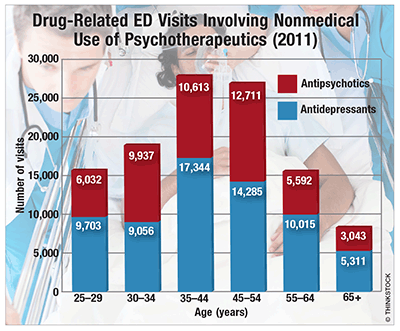US Pharm. 2014;39(11):11.
In drug-related emergency department (ED) visits, nonmedical use of psychotherapeutic drugs involves primarily antidepressants (60%) and antipsychotics (40%). Drug Abuse Warning Network data for 2011 show that 43.7 million adults (18.6%) had mental illness and 8.4 million (19.2%) had a history of illicit drug or alcohol dependence or abuse. Mentally ill women (22%) outnumbered men (14.9%), with the highest prevalence among those aged 26 to 49 years (21.2%), followed by those aged 18 to 25 (19.6%) and ≥50 (15.8%) years. More than 12% of adults used prescription medication to treat their mental-health condition. Suicidal thoughts occurred in 1.7% of adults; the percentage increased to 12.6% in cases with a history of substance-use disorder. Anxiety disorders, major depression, bipolar depression, and schizophrenia affected 18.1%, 6.7%, 2.6%, and 1.1% of adults, respectively.
![]()

Drug-Related ED Visits: Fourteen percent of visits concerned the use of multiple drugs, including psychotherapeutic agents. The number of ED visits increased by 7%, 9%, 13%, 20%, and 45%, respectively, with the use of one, two, three, four, or five or more psychotherapeutic drugs; antidepressants outnumbered antipsychotics across all categories. Sixty-seven percent of visits involved use of pharmaceuticals alone, whereas 15%, 12%, and 5% were for combined use with illicit drugs, alcohol, and illicit drugs plus alcohol, respectively. The nonmedical use of psychotherapeutic agents was most prevalent in patients aged 35-44 years (24.6%), and least prevalent among those aged ≥65 years (7.7%). However, with progression from age 25-29 to 30-34 years and from age 30-34 to 35-44 years, use increased by 32.4% and 36.7%, respectively. After a rate peak in the group aged 35-44 years, a 10.8% decline occurred between 35-44 and 45-54 years, and a decrease of 46.2% between 55-64 and ≥65 years.
Antidepressants: Antidepressants included selective serotonin reuptake inhibitors (SSRIs; 41.5%), phenylpiperazines (19.7%), tricyclics (15.4%), SSNRIs (selective serotonin norepinephrine reuptake inhibitors; 10.8%), and tetracyclics (2.5%). Among the SSRIs used were sertraline (29.3%), citalopram (23.2%), fluoxetine (20%), escitalopram (16.6%), and paroxetine (10.5%). White (60.7%) and Hispanic (60.4%) patients used antidepressants more than black patients did (43.7%). SSRIs were used predominantly by Hispanic patients (42.8%) compared with white (28%) and black patients (19.2%).
Antipsychotics: Antipsychotic agents included atypical antipsychotics (77.8%), lithium (11.7%), haloperidol (6.2%), and phenothiazine (4.2%). Among the atypical antipsychotics used were quetiapine (64.2%), risperidone (14.9%), and olanzapine (8.4%). Chlorpromazine constituted 39.3% of phenothiazine antipsychotics used nonmedically. Black patients (56.3%) used antipsychotics more than their white (39.3%) and Hispanic (39.6%) counterparts. Atypical antipsychotics were used least by Hispanic (31.2%) and white patients (32.2%) and most by black patients (48.3%).
To comment on this article, contact rdavidson@uspharmacist.com.






